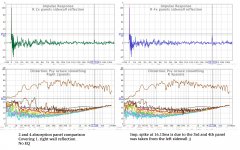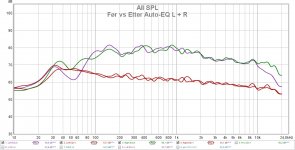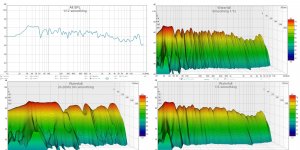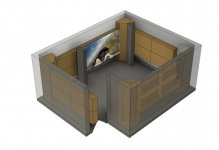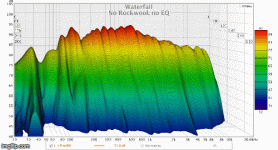that is funny.
Here I am sitting in my converted garage/man cave enjoying music when I could be measuring and tweaking the EQ or treatment to make my graphs look better. I think its funny/curious that if you get certain things right in the acoustics the rest don't matter so much. As you are experiencing it doesn't have to measure near perfect to sound really good.
(I'm convinced I need more treatments to get better measurements but I can't do that for now so I'm must enjoying)
That's your brain at work, doing it's own EQ. It has worked real hard to learn to do that during most of our lives. Want to hear that room? Record it at the listening spot and listen through headphones.
There's still enough room for experiments though. You won't believe the differences that can be heard by varying some of the variables in DRC. Do you want a more focussed imaging? Make the upper frequency dependent window slightly longer. The mid frequency window should stay as short as possible if you want to keep a natural kind of sound. The upper part is more forgiving.
Play with mid/side EQ as well, another game changer. The more the first reflections are down, the more obvious the results of mid/side EQ will be. It can become quite creepy, sounding more real every step of the way, but all in all it is a slow process that seems to be filled with lots of compromises.
Personally, I value tonal balance over imaging, but try real hard to get both as good as I can. The biggest problem is that there are so many variables at play, the room being the biggest by far, overall frequency curve (tonal balance) being a close but very important second to influence how/what we hear.
For instance, the more you control the room reflections, the more obvious the stereo cross talk becomes. I can imagine that lots of people don't ever want to go that far, as a fine mainly diffuse room can sound really good by itself. However I did go that route (on purpose) and it literary sucks you into the music if you get it to work. Very satisfying! It's never easy though, it has been a slow process that I will continue to work on. Oh, the horror to listen to all those beautiful songs! 😀
One thing I can promise, the more you get it right, the more songs that start to make sense. Sure bad recordings do exist, but a lot less so than many may assume.
It remains quite clear that there are differences in recording styles through the decades, much like you can 'date' a movie upon it's used color balance. I love many of the 70's recordings where good recording studios were still the norm. The 80's vary much more and we all know the later period with loudness wars didn't do the music justice. Still it can be amazing what a good engineer can get out of that limited dynamic range.
I don't blame anyone not willing to go this far, but if you want to try, the old Live End/ Dead End approach starts to make a lot of sense.
Last edited:
Halair apparently has a well tamed room and is in position to do well with your suggestions. Mine still needs taming. I don't think I can deaden the end enough to kill those LF longitudinal room modes I have. I also have some 15-20 ms side and rear wall reflections (late enough for my brain to ignore?) mucking with the 100 to 300 Hz range but above that everything is pristine. I thank that and the excellent channel balance I've managed to establish accounts for my satisfaction.
Here are the non-EQ measurements from sweet spot for top right (RT), bottom right
(RB) and LT/LB (1/12 smoothered). The idea is to use these measurements to generate EQ-profiles I can play with. (1/12 smoothered)
Measurements are done at 80dB calibrated.
For the Left side there is a bigger difference between top/bottom group between 40-90hz, otherwise they are more or less on line with eachother.
There is also a 3rd plot with the average response from RT+RB is shown, along to LT/LB.
That looks like ana easy EQ. Congratulations!!
//
That looks like ana easy EQ. Congratulations!!
Thanks, I still feel I have a lot of that race ahead of me 😀
First arrays I built 5 years ago was just a quick dash to get some, and I have lived happily with those since then. Insert kid with poking stick and having access to CNC prompted my mk2 build 🙂
Now I should have a better starting point, cabinets with greatly reduced resonances on hand 🙂 I might need to alter the damping panel arrangement for my room as the mk2's need to be further out in the room due to lack of ceiling/soffit clearance, so the right sidewall reflection is more pronounced.
I have also increased total Sd with 20% and 2x amp power compared to mk1 so I might also need/want better damping in the LF region. I can manage 25cm of Rockwool behind the listening position which also assist in a better LiveEnd/DeadEnd enviroment.
For now, the holiday have been spent mostly enjoying the arrays, reading about REW/methology slowly building up with knowledge to start the process to nail this to the ground 😛
I am sure, learning by doing 😛
Here is a distortion and impulse measurement for the right array, this is the array that is close to the sidewall (approx 45-50cm). This wall have two absorption panels and I wanted to see the effect of more
Each panel is 125mm thick, using 75mm Rockwool + 50mm air.
So left set of data is with 2 panels and the right side is with 4.
No EQ applied.
As seen the distortion drop in the 60-80hz range.
Funny side effect, the 3rd and 4th panel was taken down from the left wall and now appear as a spike in the IR!
Here is a distortion and impulse measurement for the right array, this is the array that is close to the sidewall (approx 45-50cm). This wall have two absorption panels and I wanted to see the effect of more

Each panel is 125mm thick, using 75mm Rockwool + 50mm air.
So left set of data is with 2 panels and the right side is with 4.
No EQ applied.
As seen the distortion drop in the 60-80hz range.
Funny side effect, the 3rd and 4th panel was taken down from the left wall and now appear as a spike in the IR!

Attachments
First attempt with an auto-EQ excersise just to learn what the miniDSP favour.
The SPL slope is a little too steep (13dB span) and too rich on the low end, will try a gentler slope next time. Vocals and string instruments a little too tamed down.
L + R measurements was done at 75dB and the miniDSP target level was tested at 63dB
The SPL slope is a little too steep (13dB span) and too rich on the low end, will try a gentler slope next time. Vocals and string instruments a little too tamed down.
L + R measurements was done at 75dB and the miniDSP target level was tested at 63dB
Attachments
Its been too buzy the past few days for any serious progress so I have just enjoyed what I have 😀
I have also drafted some acoustic measures I would like to incorporate over time, which consist of Rockwool corner traps for the high energy areas and added wall damping. Two bales was purchased yesterday and lined up on the rear wall. Due to the "room chamber" I have as listening area it is getting a little "hot" in terms of bass, so I am incorporating measures to optimize the room.
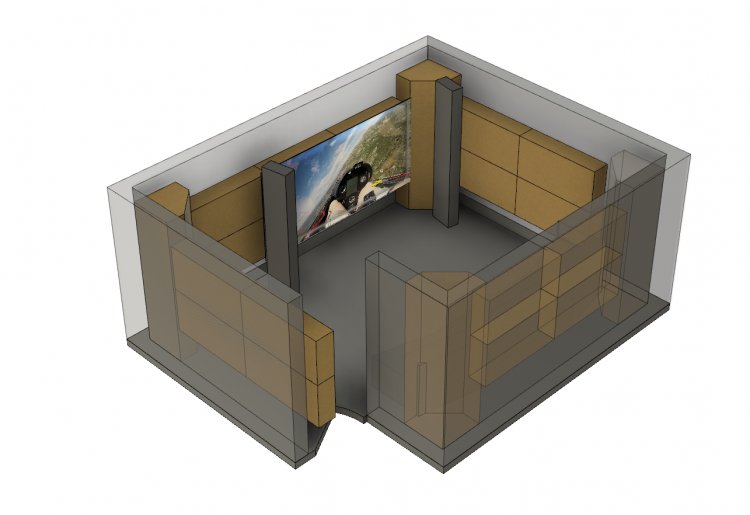
List of measures, in prioritized sequence (=bales req´d):
Since the room is a major variable in the system as a whole I havent spent much time DSP´ing the past few days. (time have been to short anyways for any serious efforts)
I have also drafted some acoustic measures I would like to incorporate over time, which consist of Rockwool corner traps for the high energy areas and added wall damping. Two bales was purchased yesterday and lined up on the rear wall. Due to the "room chamber" I have as listening area it is getting a little "hot" in terms of bass, so I am incorporating measures to optimize the room.
List of measures, in prioritized sequence (=bales req´d):
- Treat the two rear corners (3)
- Treat the rear wall (40cm behind couch, 20cm at ear level and above (3)
- Corner traps front (3)
- 20cm panels behind projected screen (2)
- Front wall (2)
Since the room is a major variable in the system as a whole I havent spent much time DSP´ing the past few days. (time have been to short anyways for any serious efforts)
Attachments
Last edited:
😱
I do hope you plan to use ambient channels with that much damping. Otherwise you'd simply loose too much to be comfortable. At least I would think you'd miss part of the room ambience.
I do hope you plan to use ambient channels with that much damping. Otherwise you'd simply loose too much to be comfortable. At least I would think you'd miss part of the room ambience.
Incremental approach, it is not certain it will ever reach the state visualized 😀
CAD model primarely used to calculate damping volume.
Also undecided wether to go with damping vs diffusion for the "screen" area between the arrays, as damping may attenuate the ambience effect.
Scattered (Diffusion) front wall may win 😉
But in the time domain I have much residiual energy in the LF-region and taming that a little is the primary goal.
CAD model primarely used to calculate damping volume.
Also undecided wether to go with damping vs diffusion for the "screen" area between the arrays, as damping may attenuate the ambience effect.
Scattered (Diffusion) front wall may win 😉
But in the time domain I have much residiual energy in the LF-region and taming that a little is the primary goal.
Do test each step of the way. I have no absorption at all behind the speakers.
I have tested it but did not notice a positive change. Damping or absorbing too much may lead to unsatisfactory results.
Concentrate on the absorption of those lower frequencies first. Near wall placement of the array will help produce lower notes. But there will always be some transition area. I see that in both the arrays and sub results. That's where some DSP manipulation can help.
I have tested it but did not notice a positive change. Damping or absorbing too much may lead to unsatisfactory results.
Concentrate on the absorption of those lower frequencies first. Near wall placement of the array will help produce lower notes. But there will always be some transition area. I see that in both the arrays and sub results. That's where some DSP manipulation can help.
Testing will be done for sure 🙂
How far away are your ears from L/R array in SS?
Distance to rear wall?
At my place L/R2ear = 270cm and rear wall about 70cm further back. But to my right I have a full sidewall, but on my left I have 110cm sidewall before the corner by the access door.
How far away are your ears from L/R array in SS?
Distance to rear wall?
At my place L/R2ear = 270cm and rear wall about 70cm further back. But to my right I have a full sidewall, but on my left I have 110cm sidewall before the corner by the access door.
The trick is to add bass damping that doesn't absorb HF. The simplest first step is to use paper faced fiberglass batts with the paper side facing out. I think the paper gradually becomes reflective above 1 khz but I don't recall exactly.
But as your calculations show, it takes an awful lot of fiberglass to be effective at LF. Geddes recommends a different approach. He builds rooms with entire walls (preferably all walls and ceiling) covered with a double layer of sheetrock (gypsum board) fastened to resilient channels and separated by a layer of "green glue" a viscous damping material. This is so effective he doesn't count on corner gain or room gain in his bass calculations. Info is in his HT book on his website. I know your room is already built but I don't see why you couldn't build free standing panels this way.
But as your calculations show, it takes an awful lot of fiberglass to be effective at LF. Geddes recommends a different approach. He builds rooms with entire walls (preferably all walls and ceiling) covered with a double layer of sheetrock (gypsum board) fastened to resilient channels and separated by a layer of "green glue" a viscous damping material. This is so effective he doesn't count on corner gain or room gain in his bass calculations. Info is in his HT book on his website. I know your room is already built but I don't see why you couldn't build free standing panels this way.
... vs diffusion...
Sound Diffusers 101: Free Designs for DIY Diffuser Panels
With the release of the UBC guys diffusor paper, there are now some fairly potent wall size diffusors that are outlined in detail.
I was thinking of doing the whole wall behind the hifi in a wall-ceiling western red cedar diffusor.
dave
Yeah, GreenGlue and plaster boards would help for sure but its considerably more intrusive (room is done and painted long time ago) and more pricey.
Any wall/floor, wall/ceiling and especially corners get bass saturation, so these spots are the first line of defence. I also have soffits (30x20cm) all around the room that I can adapt the panel on to soak bass energy if it gets to that. Not lacking options 😀 Diffusion for ajacent 1.point reflection way also be something to consider but that is way into the future.
But I digress, main purpose now is to add a little more damping, primarely in corners - then getting serious with DSP

Any wall/floor, wall/ceiling and especially corners get bass saturation, so these spots are the first line of defence. I also have soffits (30x20cm) all around the room that I can adapt the panel on to soak bass energy if it gets to that. Not lacking options 😀 Diffusion for ajacent 1.point reflection way also be something to consider but that is way into the future.
But I digress, main purpose now is to add a little more damping, primarely in corners - then getting serious with DSP


Last edited:
I was thinking of doing the whole wall behind the hifi in a wall-ceiling western red cedar diffusor.
Considering an infinite line array setup, what would be more beneficial in terms of orientation of such diffusion panels, vertical or horisontal orientation? Any idea?
Perhaps an even mix would be better?
- Home
- Loudspeakers
- Full Range
- HalAir Aeralis - Fullrange Line Array (Vifa TC9-18-08)
